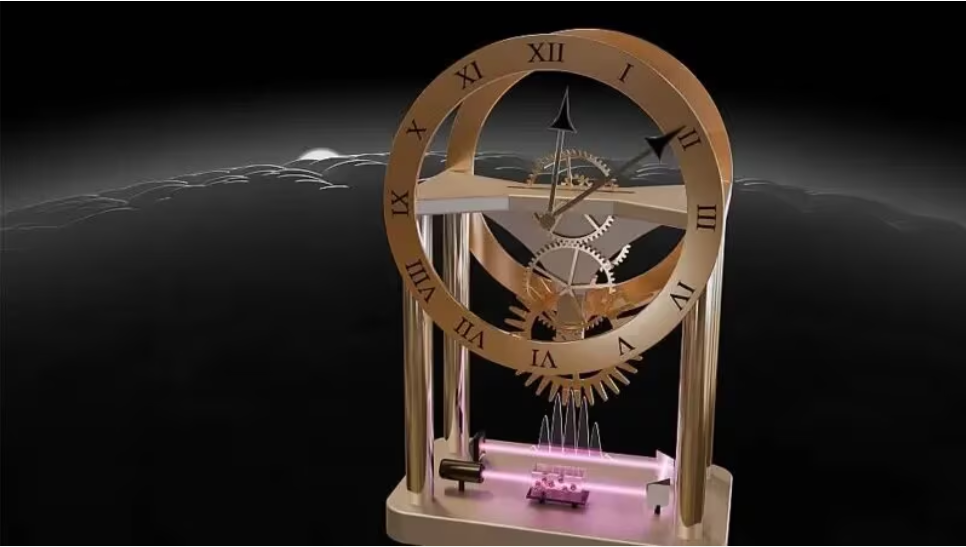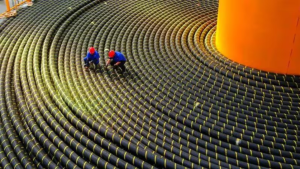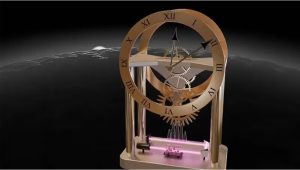
Currently the standard used worldwide to measure time is atomic clocks.
“Imagine a wristwatch that wouldn’t lose a single second even if you left it running for billions of years.”
“While we are not there yet, this research brings us closer to that level of precision.”
Physicist Jun Ye is a researcher at the National Institute of Standards and Technology (NIST) in the United States and a professor at the University of Colorado at Boulder.
And the clock he is referring to is a nuclear clock.
In a recent study featured on the cover of Nature, Ye and an international team of scientists describe the first prototype of such a watch and show that all the components it requires are already a reality.
Currently the standard used worldwide to measure time is atomic clocks .
Not only would nuclear clocks be even more precise than atomic clocks, they would help scientists explore major mysteries of the universe, such as dark matter.
Getting to this point in the development of a nuclear clock has taken decades. Why is the breakthrough described in Nature so important? And what is the difference between an atomic clock and a nuclear clock?
What is an atomic clock and how it affects your daily life?
Atomic clocks record signals of electrons changing their energy state, known as a “quantum jump.”
“Any clock has two components: something that ticks, like a pendulum, and something that counts those oscillations,” Colombian scientist Ana María Rey, a theoretical atomic physicist at NIST, professor at the University of Colorado in Boulder and expert in atomic clocks, explains to BBC Mundo.
“In a normal pendulum clock, you see that the clock has the pendulum and a mechanism that moves the pendulum and tells us how many times it has moved.”
In the case of the atomic clock, Rey adds, what oscillates (the equivalent of the pendulum) is an electromagnetic wave of light which, typically, in optical atomic clocks is a laser, and what counts the oscillations are the electrons of the atoms .
“Imagine a wristwatch that wouldn’t lose a single second even if you left it running for billions of years.”
“While we are not there yet, this research brings us closer to that level of precision.”
Physicist Jun Ye is a researcher at the National Institute of Standards and Technology (NIST) in the United States and a professor at the University of Colorado at Boulder.
And the clock he is referring to is a nuclear clock.
In a recent study featured on the cover of Nature, Ye and an international team of scientists describe the first prototype of such a watch and show that all the components it requires are already a reality.
Currently the standard used worldwide to measure time is atomic clocks .
Not only would nuclear clocks be even more precise than atomic clocks, they would help scientists explore major mysteries of the universe, such as dark matter.
Getting to this point in the development of a nuclear clock has taken decades. Why is the breakthrough described in Nature so important? And what is the difference between an atomic clock and a nuclear clock?
“The oscillations in an atomic clock can be so fast that even normal electronic devices cannot measure them.”
“But electrons, on the other hand, since they absorb energy only at certain frequencies, are what allow us to determine when the laser frequency is exactly the electron frequency, because when that happens the electron makes a transition from the base level to the excited level.”
“And since the laser has a certain number of oscillations in a certain time, that allows us to determine a universal way, a measure of time.”
It is thanks to atomic clocks that time on computers, cell phones and many other technologies, such as space research, is currently synchronized across the planet with precision of at least the sixteenth digit.
“In general, all the measurements we have depend on the measurement of time. For example, the measurement of distance is based on knowing the speed of light.”
Atomic clocks are “everywhere ,” Rey notes.
“For example, in the satellites that control GPS. When we look at our GPS and ask for instructions on how to get from one place to another, we depend on the atomic clocks that are in those satellites.”
In the case of the nuclear clock, signals from the nucleus of an atom are not used, but rather from electrons .
“As we have said, the atomic clock excites the electrons of the atom. However, the atom does not only have electrons, it also has the nucleus which is made up of protons and neutrons, and these states of the nucleus can also be excited,” explains Rey.
“The problem is that these excitations require very high energy, but a certain class of atoms, thorium, has been discovered where the energy for excitation is much lower than the standard energies found in the nucleus.”
The core only absorbs energy from a laser in a very small frequency range. And finding the exact frequency of that ultra-precise laser to generate the transition in the core has been a decades-long effort .
Rey points out that although this transition had been predicted in the 1970s, it had not been found because it was like “finding a needle in a haystack.”
What the scientists in the study in the journal Nature have now managed to do is use a specially designed ultraviolet laser to precisely measure the frequency of an energy jump in thorium nuclei embedded in a solid crystal .
“The nuclear clock uses a quantum jump inside the atomic nucleus, which is even a factor of 1000 smaller than the atom itself. Our work has shown for the first time that this is possible. In this case, it is a neutron that jumps to a different energy state,” German scientist Thorsten Schumm, a researcher at the Vienna University of Technology and another of the authors of the study, explains to BBC Mundo.
“Imagine a wristwatch that wouldn’t lose a single second even if you left it running for billions of years.”
“While we are not there yet, this research brings us closer to that level of precision.”
Physicist Jun Ye is a researcher at the National Institute of Standards and Technology (NIST) in the United States and a professor at the University of Colorado at Boulder.
And the clock he is referring to is a nuclear clock.
In a recent study featured on the cover of Nature, Ye and an international team of scientists describe the first prototype of such a watch and show that all the components it requires are already a reality.
Currently the standard used worldwide to measure time is atomic clocks .
Not only would nuclear clocks be even more precise than atomic clocks, they would help scientists explore major mysteries of the universe, such as dark matter.
Getting to this point in the development of a nuclear clock has taken decades. Why is the breakthrough described in Nature so important? And what is the difference between an atomic clock and a nuclear clock?
How a nuclear clock works
In the case of the nuclear clock, signals from the nucleus of an atom are not used, but rather from electrons .
“As we have said, the atomic clock excites the electrons of the atom. However, the atom does not only have electrons, it also has the nucleus which is made up of protons and neutrons, and these states of the nucleus can also be excited,” explains Rey.
“The problem is that these excitations require very high energy, but a certain class of atoms, thorium, has been discovered where the energy for excitation is much lower than the standard energies found in the nucleus.”
The core only absorbs energy from a laser in a very small frequency range. And finding the exact frequency of that ultra-precise laser to generate the transition in the core has been a decades-long effort .
Rey points out that although this transition had been predicted in the 1970s, it had not been found because it was like “finding a needle in a haystack.”
What the scientists in the study in the journal Nature have now managed to do is use a specially designed ultraviolet laser to precisely measure the frequency of an energy jump in thorium nuclei embedded in a solid crystal .
“The nuclear clock uses a quantum jump inside the atomic nucleus, which is even a factor of 1000 smaller than the atom itself. Our work has shown for the first time that this is possible. In this case, it is a neutron that jumps to a different energy state,” German scientist Thorsten Schumm, a researcher at the Vienna University of Technology and another of the authors of the study, explains to BBC Mundo.
Schumm believes that the nuclear clock will be a reality in the near future.
“I think things will move very quickly from now on. In just one year we have seen incredible progress and I can promise more wonderful things to come.”
“ What is most needed is development on the laser side… I would say it will take no more than five years .”
“With this first prototype we have demonstrated that thorium can be used as a chronometer for very high-precision measurements. All that remains is the technical development work, with no major obstacles to be expected.”
A new window to the universe
Although the nuclear clock would be even more precise than the atomic clock, Schumm explains that “the advantage of the nuclear clock is not so much its better performance but its greater stability .”
“Because the core is so small and the nuclear forces involved are so enormous, external perturbations like temperature or magnetic fields don’t really affect it. So it’s a much more robust clock.”
“You can even embed a very high number of cores into some simple portable material, such as glass, without degrading performance.”
Beyond their technological applications, something that scientists are particularly excited about is that nuclear clocks will open a new door to the study of the Universe.
“The nuclear clock is insensitive to external forces, but it is very sensitive to internal forces acting within the nucleus . These are electromagnetic forces, but also nuclear forces, which hold the nucleus together. The latter in particular are very difficult to investigate, so the nuclear clock will also act as a sensor for some of the fundamental forces of nature,” says Schumm.
What are some of the questions that might be possible to explore with a nuclear clock?
“There are many aspects of the universe that we still don’t understand,” Rey says.
“For example, we know that more than 80% of the constituents of the universe are not normal matter, but dark matter that we don’t understand. And it’s possible that by operating a nuclear clock that is quite sensitive to many effects that normal atomic clocks are not sensitive to, we may have a key to understanding what the origin of that dark matter is .”
Nuclear clocks can also be compared with atomic clocks, allowing us to study whether natural constants thought to be universal, such as the speed of light, are actually invariant over time and space.
“There are a lot of questions that we don’t know yet,” says Rey.
“So it is a window for future research that will allow us to discover more things about the universe. Whenever this happens, we arrive at better technological developments.”
“Imagine a wristwatch that wouldn’t lose a single second even if you left it running for billions of years.”
“While we are not there yet, this research brings us closer to that level of precision.”
Physicist Jun Ye is a researcher at the National Institute of Standards and Technology (NIST) in the United States and a professor at the University of Colorado at Boulder.
And the clock he is referring to is a nuclear clock.
In a recent study featured on the cover of Nature, Ye and an international team of scientists describe the first prototype of such a watch and show that all the components it requires are already a reality.
Currently the standard used worldwide to measure time is atomic clocks .
Not only would nuclear clocks be even more precise than atomic clocks, they would help scientists explore major mysteries of the universe, such as dark matter.
Getting to this point in the development of a nuclear clock has taken decades. Why is the breakthrough described in Nature so important? And what is the difference between an atomic clock and a nuclear clock?
Feel the beauty of physics
Schumm described to BBC Mundo what it felt like to find the precise frequency to change the state of a thorium nucleus.
“It’s just amazing! We spend most of our time building things and fixing components that are broken, so there is little (or no) progress, and we think a lot about how fantastic it would be if it finally worked. And it really did! Few researchers are privileged and lucky enough to live through this moment , and I thank my team and collaborators for having persisted for so long.”
“We can now take many of the powerful tools that have been developed in atomic physics and quantum optics and transfer them to nuclear physics. I would say that there are enough open questions for a whole generation of scientists!” added the scientist from the Vienna University of Technology.
Both the atomic and nuclear clocks also show how research in theoretical physics can end up impacting the daily lives of billions of people.
“In general, theoretical physics creates the models that allow experiments to try to understand how our universe behaves ,” says Ana María Rey.
“All computers, for example, are based on transistors. And transistors exist because we understand quantum mechanics. We understand, for example, how electrons move in a metal, all of that requires an understanding of quantum mechanics.”
“Theoretical physics is what gives us a way to interpret why this behavior happens and makes predictions of new ways in which nature can behave. And it is that interaction between the predictions made by theoretical physics and experiment that leads to discoveries that advance technology in everyday life in electronics, communications, transportation. It is all due to our understanding of quantum mechanics indirectly.”
“And nuclear clocks can open up another way of understanding quantum mechanics that we don’t have now.”
In an interview with Optica , an American society that promotes advancement in this scientific field, Ana María Rey recalled that she found her calling after a eureka moment during her first physics class.
“All the numbers and concepts in my mind came alive. I felt the beauty of physics; it governs our universe, from the motions of electrons inside an atom to the behavior of black holes .”
“It was a puzzle that could tell us everything about the world, and I was fascinated by solving it.”
Does Rey still feel the beauty of his discipline in his current work with watches?
“Of course, every day,” he told BBC Mundo.
“I come to work with the excitement of being able to try to discover aspects of physics that can tell us in an equation how the universe behaves. For me, it is something fascinating: How can we describe mathematically what is going to happen if we apply this thing? If we illuminate an atom with a certain frequency of light, how is it going to behave? What is going to happen?”
“Being able to predict with a mathematical model what is going to happen is like magic and that is what I found fantastic. If I can tell the experimentalist with my theory, apply this, measure that and you will find this and you find it, it is the best thing that can happen.”





